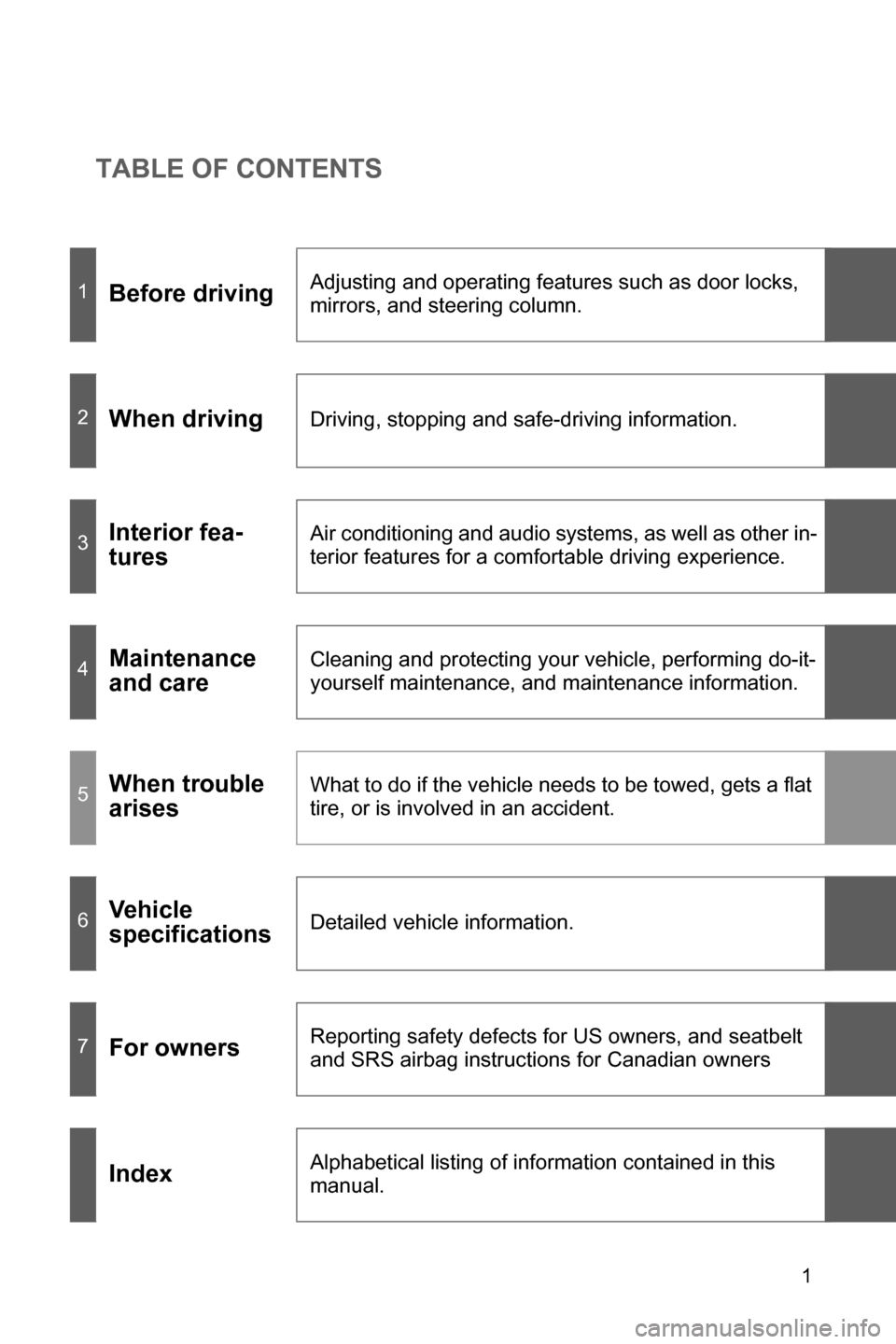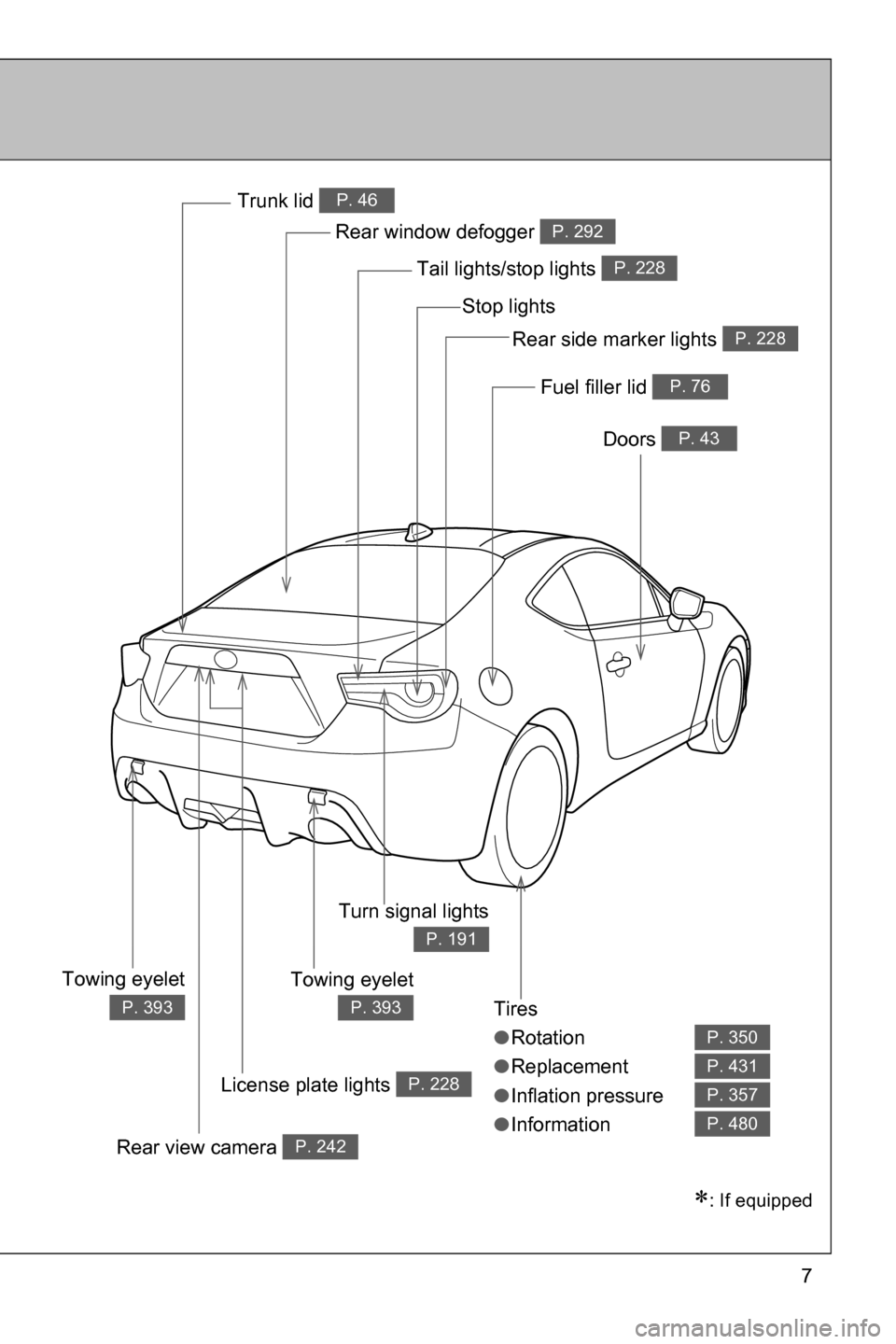2017 SUBARU BRZ tow
[x] Cancel search: towPage 3 of 540

TABLE OF CONTENTS
1
1Before drivingAdjusting and operating features such as door locks,
mirrors, and steering column.
2When drivingDriving, stopping and safe-driving information.
3Interior fea-
turesAir conditioning and audio systems, as well as other in-
terior features for a comfortable driving experience.
4Maintenance
and careCleaning and protecting your vehicle, performing do-it-
yourself maintenance, and maintenance information.
5When trouble
arisesWhat to do if the vehicle needs to be towed, gets a flat
tire, or is involved in an accident.
6Vehicle
specificationsDetailed vehicle information.
7For ownersReporting safety defects for US owners, and seatbelt
and SRS airbag instructions for Canadian owners
IndexAlphabetical listing of information contained in this
manual.
Page 5 of 540

1
2
3
4
5
6
7
3
2-2. Instrument cluster
Gauges and meters ............ 194
Indicators and warning
lights ................................. 198
Multi-information display
(monochrome display) ...... 205
Multi-information display
(color display) ................... 213
2-3. Operating the lights and
windshield wipers
Headlight switch .................. 228
Fog light switch ................... 233
Windshield wipers and
washer .............................. 234
2-4. Using other driving
systems
Cruise control ...................... 237
Rear view camera ............... 242
Driving assist systems ........ 251
Hill start assist ..................... 258
2-5. Driving information
Cargo and luggage ............. 263
Vehicle load limits ............... 267
Winter driving tips ............... 268
Trailer towing ...................... 273
Dinghy towing ..................... 2743-1. Using the air conditioning
system and defogger
Manual air conditioning
system .............................. 276
Automatic air conditioning
system .............................. 283
Rear window and outside
rear view mirror
defoggers ......................... 292
3-2. Using the audio system
Using the AUX/USB port .... 294
Using the microphone ........ 295
3-3. Using the interior lights
Interior lights list ................. 296
• Interior light ...................... 297
3-4. Using the storage features
List of storage features ....... 298
• Glove box ......................... 299
• Bottle holders ................... 300
• Cup holders/
console tray ...................... 301
3-5. Other interior features
Sun visors........................... 303
Vanity mirrors ..................... 304
Clock .................................. 305
Power outlets...................... 306
Seat heaters ....................... 308
Floor mat ............................ 310
3Interior features
Page 6 of 540

TABLE OF CONTENTSIndex
4
4-1. Maintenance and care
Cleaning and protecting
the vehicle exterior ........... 314
Cleaning and protecting
the vehicle interior ............ 318
Cleaning and protecting
the Alcantara
® area.......... 322
4-2. Maintenance
Maintenance
requirements .................... 324
General maintenance ......... 327
Emission inspection and
maintenance (I/M)
programs .......................... 330
4-3. Do-it-yourself
maintenance
Do-it-yourself service
precautions ...................... 331
Engine hood ....................... 334
Engine compartment .......... 336
Tires ................................... 350
Tire inflation pressure......... 357
Wheels ............................... 361
Air conditioning filter ........... 364
Transmitter/access key
battery .............................. 367
Checking and replacing
fuses ................................ 372
Light bulbs .......................... 3805-1. Essential information
Hazard warning flashers ..... 392
If your vehicle needs to
be towed ........................... 393
If you think something is
wrong ................................ 400
Fuel pump shut off
system .............................. 401
5-2. Steps to take in an
emergency
If a warning light turns
on or a warning buzzer
sounds... .......................... 402
If a warning message is
displayed .......................... 414
If you have a flat tire ........... 431
If the engine will not start .... 444
If the select lever cannot
be shifted from P .............. 447
If you lose your keys ........... 448
If the access key does
not operate properly ......... 449
If the battery is
discharged ........................ 453
If your vehicle
overheats .......................... 458
If the vehicle becomes
stuck ................................. 461
4Maintenance and care5When trouble arises
Page 8 of 540

6
Outside rear view mirrors P. 69Engine hood P. 334
Windshield wipers P. 234
Headlights P. 228
Parking lights/daytime running
lights
P. 228
Front side marker
lights
P. 228
Turn signal lights P. 191
Front fog lights �
P. 233
Pictorial indexExterior
Towing eyelet P. 393
Page 9 of 540

7
Tires
●Rotation
●Replacement
●Inflation pressure
●Information
P. 350
P. 431
P. 357
P. 480
Rear window defogger P. 292
Trunk lid P. 46
Doors P. 43
Fuel filler lid P. 76
Turn signal lights
P. 191
Rear side marker lights P. 228
�
: If equipped
License plate lights P. 228
Tail lights/stop lights P. 228
Towing eyelet
P. 393
Towing eyelet
P. 393
Rear view camera P. 242
Stop lights
Page 33 of 540

31 1-2. Opening, closing and locking the doors and trunk lid
1
Before driving
■Conditions affecting operation
The keyless access with push button start system uses weak radio waves. In
the following situations, the communication between the access key and the
vehicle may be affected, preventing the keyless access with push button
start system, remote keyless entry system and engine immobilizer system
from operating properly. (Way of coping �oP. 449)
●When the access key battery is depleted
●Near a TV tower, electric power plant, gas station, radio station, large dis-
play, airport or other facility that generates strong radio waves or electri-
cal noise
●When the access key is in contact with, or is covered by the following
metallic objects
• Cards to which aluminum foil is attached
• Cigarette boxes that have aluminum foil inside
• Metallic wallets or bags
• Coins
• Hand warmers made of metal
• Media such as CDs and DVDs
●When another transmitters (that emit radio waves) are being used nearby
●When carrying the access key together with the following devices that
emit radio waves
• A portable radio, cellular phone, cordless phone or other wireless com-
munication device
• Another vehicle's access key or a transmitter that emits radio waves
• Personal computers or personal digital assistants (PDAs)
• Digital audio players
• Portable game systems
●If window tint with a metallic content or metallic objects are attached to
the rear window
●When the access key is placed near a battery charger or electronic
devices
Page 43 of 540

41 1-2. Opening, closing and locking the doors and trunk lid
1
Before driving
■Conditions affecting operation
Vehicles without a keyless access with push button start system
The remote keyless entry system may not operate normally in the following
situations:
●When the transmitter battery is depleted
●Near a TV tower, electric power plant, gas station, radio station, large dis-
play, airport or other facility that generates strong radio waves or electri-
cal noise
●When carrying a portable radio, cellular phone or other wireless commu-
nication devices
●When the transmitter is in contact with, or is covered by a metallic object
●When other transmitters (that emit radio waves) are being used nearby
●If window tint with a metallic content or metallic objects are attached to
the rear window
Vehicles with a keyless access with push button start system
�oP. 3 1
■If the remote keyless entry system does not operate properly (vehicles
with a keyless access with push button start system)
Locking and unlocking the doors, unlocking the trunk lid: Use the mechanical
key. (�oP. 449)
■Key battery depletion
Vehicles without a keyless access with push button start system
If the remote keyless entry system does not operate, the battery may be
depleted. Replace the battery when necessary. (�oP. 367)
Vehicles with a keyless access with push button start system
�oP. 3 5
■When the access key battery is fully depleted
�oP. 367
■Confirmation of the registered key number
The number of keys already registered to the vehicle can be confirmed. Ask
your SUBARU dealer for details.
■Customization that can be configured at your SUBARU dealer
Settings (e.g. remote keyless entry system) can be changed.
(Customizable features �oP. 493)
Page 100 of 540

98 1-7. Safety information
SUBARU advanced frontal airbag system
Your vehicle is equipped with a SUBARU advanced frontal airbag
system that complies with the new advanced frontal airbag require-
ments in the amended Federal Motor Vehicle Safety Standard
(FMVSS) No. 208.
The SUBARU advanced frontal airbag system automatically deter-
mines the deployment force of the driver’s SRS frontal airbag at the
time of deployment as well as whether or not to activate the front pas-
senger’s SRS frontal airbag and, if activated, the deployment force of
the SRS frontal airbag at the time of deployment.
Your vehicle has warning labels on the driver’s and front passenger’s
sun visors beginning with the phrase “EVEN WITH ADVANCED AIR
BAGS” and a tag attached to the glove box lid beginning with the
phrase “Even with Advanced Air Bags”. Make sure that you carefully
read the instructions on the warning labels and tag.
Always wear your seatbelt. The SUBARU advanced frontal airbag
system is a supplemental restraint system and must be used in com-
bination with a seatbelt. All occupants should wear a seatbelt or be
seated in an appropriate child restraint system.
The driver’s SRS frontal airbag is stowed in the center portion of the
steering wheel. The front passenger’s SRS frontal airbag is stowed
near the top of the dashboard under an “SRS AIRBAG” mark.
In a moderate to severe frontal collision, the following components
deploy.
●SRS frontal airbag for driver
●SRS frontal airbag for front passenger
These components supplement the seatbelts by reducing the impact
to the occupant’s head and chest.